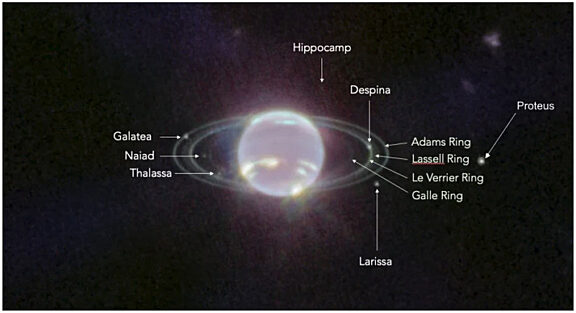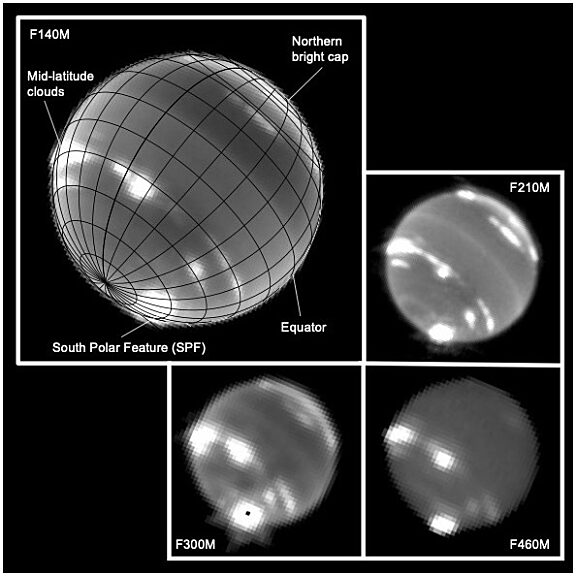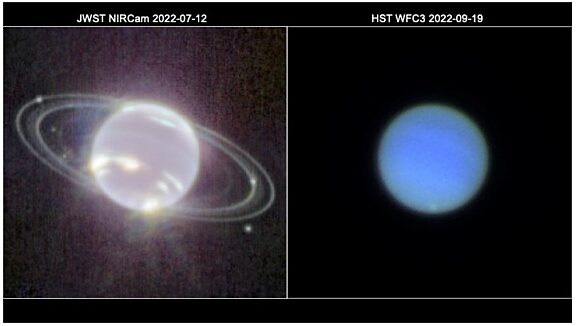A deep dive into the Neptune system with JWST
On Sep. 21, 2022, the James Webb Space Telescope (JWST) turned its golden mirrors toward the ice giant Neptune. This planet, like its fraternal twin Uranus, is one of the least explored planets in our Solar System, only briefly visited by Voyager 2 in 1989. Its extreme distance from Earth makes it extraordinarily difficult to study with even the world’s largest telescopes, but efforts to study Neptune are well worth the investment.
We know so little about ice giants that studies of the Neptune system are largely in the realm of pure scientific discovery. Each new thing we learn about Neptune makes a huge contribution to our understanding of it. Studying Neptune can also give us insights into worlds beyond the Solar System; our studies of planetary systems around other stars suggest that objects in the size range of Neptune are abundant throughout our galactic neighborhood.
Until a mission is sent to study an ice giant up close, advances in understanding this important class of planets will rely crucially on JWST and other telescopes. And although JWST has only captured a brief glimpse of the Neptune system, we are already seeing just how much this powerful telescope might be able to tell us about the planet, its rings and moons, and potentially other similar worlds.

Welcome back to the Neptune system
In 1989, the Voyager 2 spacecraft delivered our best images to date of the Neptune system during a brief flyby. Voyager 2 revealed a planet with a dynamic atmosphere and a rich ring system. The flyby also demonstrated that Neptune’s largest moon, Triton, harbored a complex surface and active cryovolcanoes that were resurfacing the moon’s south polar region in real time. In the decades since Voyager, Neptune scientists have turned Earth’s best ground- and space-based telescopes toward this remote world. Its extreme distance, however, helped the planet keep its secrets close.
JWST, with its exquisite infrared sensitivity, opens a new window into the Neptune system. The first JWST images of Neptune show myriad cloud features, the bright shine of Triton’s icy surface, many of Neptune’s moons, and its system of rings.

Neptune’s clumpy rings
The ring system was the surprise breakout star of the JWST Neptune images. In recent decades, our largest telescopes had only been able to image the densest parts of Neptune’s rings, and only barely. JWST’s first images contain a great deal of information about the ring set, including important details that we can tease out by looking at the original source frames.
The first detections of Neptune’s rings (like those of Uranus) came from occultations. Astronomers monitored a star as the Neptune system passed in front of it, and looked for a tell-tale “blink” of the star as a ring blocked the starlight. Oddly, though, sometimes there were “blinks” that seemed to come from rings, yet at other times there was no “blink.” There was extensive debate in the planetary science community about what this might mean – mistakes in the occultation analyses? Partial rings?
Voyager resolved the riddle of the rings when it imaged the complete Neptune system: the ring system was indeed complete, but certain regions were distinctly thicker and brighter within the bright outermost Adams ring (named, like all of Neptune’s rings, after an astronomer who played a crucial role in the planet’s discovery). These clumps or “arcs” orbit around the planet like moons, and therefore appear at different places at different times. Hence, occultations could sometimes detect them, but not at other times. Mystery solved!
Subsequent attempts to directly image the Neptune ring system were occasionally successful for the densest arcs, but the fainter dust sheets were beyond the grasp of even the most powerful telescopes. The diffuse Galle ring, closest to the planet, is Neptune’s faintest ring. The next ring from the planet is the crisply-defined LeVerrier ring, which is actually a bright inner edge to the wider and more diffuse Lassell ring. The outer edge of the Lassell ring is called the Arago ring.
Enter the newest JWST images. Even in these short exposures, the entire Neptune ring system popped right out. These amazing images are due to the exquisite sensitivity of JWST’s cameras, combined with the remarkable stability of its mirrors. Together, these qualities permit the detection of extremely faint structures next to extremely bright objects (see also the JWST image of the rings of Jupiter, which are clearly detected despite being a million times fainter than the nearby disk of the planet).

In the composite Neptune images it is hard to see the arcs, but in the individual exposures they are quite evident. Earlier Keck Observatory images had hinted at changes in Neptune ring arc brightness and location, and the new JWST data provide a rich complement to those data. Future JWST papers will explore the evolving rings of Neptune.
Astonishing activity in the atmosphere of Neptune
JWST’s near-infrared-viewing powers allow us to examine different levels of Neptune’s atmosphere because of the nature of the molecule methane, which gives both of the ice giants’ atmospheres their distinctive bluish color. Methane absorbs light differently at various wavelengths; by selecting wavelengths of light that aren’t absorbed by methane, JWST can peer into deeper levels of the atmosphere. This also allows JWST to identify high-altitude clouds that scatter sunlight before it is absorbed by the methane below.

A major feature that can be seen in all filters is the South Polar Feature (SPF), which is not actually located at Neptune’s south pole, but instead circles it at a latitude of about -70°. It was first reported in 1989 when Voyager 2 did its flyby, and has been a persistent feature at Neptune ever since. The SPF is a clump of clouds so condensed that it usually appears as one feature in most images. In one of the JWST filters (F300M at 3 microns), the SPF is so bright that it caused the only instance of saturation in the Neptune campaign. This saturation can be seen as a black dot in the center of the feature. With the sensitivity of JWST, we can resolve the separate clouds that make up this feature.
JWST detected other structures at the south pole as well. At 2.1 microns (F210M) JWST saw a bright polar vortex that had been observed in the past, as well as a bright continuous band surrounding the pole that had not been detected before — not because we didn’t have the sensitivity, but because it had not been there in the past. The band is around the same brightness as the polar vortex, so if it had existed when the polar vortex was observed it would have been spotted as well. Neptune specialists are excited to continue observations of this new feature and the others accessible by JWST.
Moving from the poles to the equator, JWST’s observing powers continue to yield new insights. The brightness of the planetary disk changes depending on latitude, and such differences are of great interest to atmospheric scientists. The Neptune images from JWST reveal a bright equatorial band at 2.1 and 3 microns, thought to be created by global circulation patterns: the atmosphere sinks at the equator, and as it sinks it compresses and warms up, causing this bright warm band around the planet. At 1.4 microns we see something different and intriguing: a clear discontinuity right at the equator between the bright southern hemisphere and the darker northern hemisphere. These surprising observations are already prompting active discussion among the community of scientists studying the atmospheres of ice giants.
Neptune’s many moons
In JWST’s wide-field image of Neptune you can see its largest moon, Triton. Triton’s odd retrograde (backwards) and tilted orbit leads planetary scientists to speculate that this object is not a native moon of Neptune. Rather, Triton is likely a Kuiper Belt Object like Pluto that strayed just a little too close to Neptune sometime in the distant past and was captured by the ice giant’s strong gravitational field. Future JWST observations will focus on a detailed examination of the infrared colors of Triton. We hope to learn more about its surface composition, its thin atmosphere, and how it compares to other large Kuiper Belt Objects such as Pluto, Eris, Makemake, Haumea, and others that JWST will observe.
Triton aside, at least six other known moons of Neptune are definitively detected in the JWST images. Despina and Galatea are embedded within the rings and are thought to be responsible for helping to craft the detailed ring structure. Naiad and Thalassa are found within the inner, dustier parts of the rings system. External to the rings, the moons Proteus and Larissa can be easily detected. Hippocamp, a tiny moon detected in 2013 is tentatively visible; moon specialists are working on enhancing the images to confirm this detection. The other known moons orbit so far from Neptune that they do not appear even in the wide field images, like Neptune’s moon Nereid, which orbits at an average distance of more than 5 million kilometers (more than 3 million miles). Future JWST images may observe some of these more distant moons.
More JWST Neptune data still to come!
All of the JWST data shown above come from less than two hours of observations, taken to demonstrate the imaging capability of JWST. The best is yet to come. There is an entire JWST science program devoted to the Neptune system, and another planned for Uranus. These two programs also hope to use the Hubble Space Telescope alongside JWST to do near-simultaneous observations in the visible and infrared spectra, expanding the scope of ice giant studies.

There is also a separate JWST program that includes observations of Neptune’s largest moon Triton. Planetary scientists are especially interested in using JWST’s observations to compare Triton and Pluto, which can be thought of as fraternal twins much like Uranus and Neptune. Triton and Pluto have comparable sizes and similar mean distances from the Sun, but have evidently followed quite different evolutionary paths. By comparing their current surface compositions, we hope to gain insight into how those divergent histories manifest themselves in the modern Solar System.
Because of the design of JWST and its orbit around the Lagrange 2 point, studies of Neptune and Triton have very limited windows in which observations can be obtained. The next window for Neptune observations opens later in the spring of 2023. Our appetite has just been whetted by this brief glimpse of Neptune, its rings, and its moons.
Support our core enterprises
Your gift today will go far to help us close out the year strong and keep up our momentum in 2026.
Donate

 Explore Worlds
Explore Worlds Find Life
Find Life Defend Earth
Defend Earth



